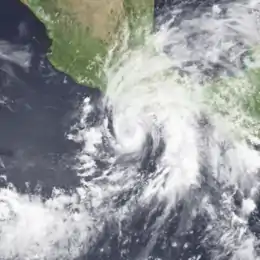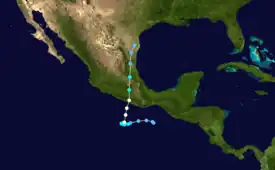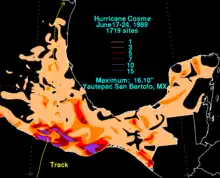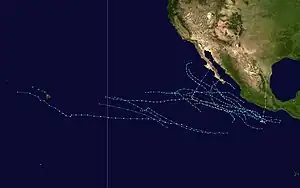Hurricane Cosme (1989)
Hurricane Cosme was an unusually large tropical cyclone that made landfall in south-western Mexico in June 1989. The third tropical storm and second hurricane of the 1989 Pacific hurricane season, Cosme formed on June 19 from a tropical wave, the storm initially moved westward before being upgraded into Tropical Storm Cosme. It ultimately intensifying into a Category 1 hurricane. Cosme turned northward and made landfall near Acapulco during the night of June 21. It rapidly weakened over land. The storm caused excessive rainfall on land, leading to deadly and destructive flooding. It is estimated that 30 people died in the hurricane.
| Category 1 hurricane (SSHWS/NWS) | |
 Hurricane Cosme at peak intensity off the southwest coast of Mexico on June 21 | |
| Formed | June 19, 1989 |
|---|---|
| Dissipated | June 23, 1989 |
| Highest winds | 1-minute sustained: 85 mph (140 km/h) |
| Lowest pressure | 979 mbar (hPa); 28.91 inHg |
| Fatalities | 30 |
| Areas affected | Mexico, East Texas |
| Part of the 1989 Pacific hurricane season | |
Meteorological history

Tropical storm (39–73 mph, 63–118 km/h)
Category 1 (74–95 mph, 119–153 km/h)
Category 2 (96–110 mph, 154–177 km/h)
Category 3 (111–129 mph, 178–208 km/h)
Category 4 (130–156 mph, 209–251 km/h)
Category 5 (≥157 mph, ≥252 km/h)
Unknown
In early June 1989, a tropical wave emerged from the west coast of Africa and traversed the Atlantic Ocean, eventually crossing into the eastern North Pacific. Initially, several centers of circulation were associated with the system. Continuing organize,[1] the storm is estimated to have attained tropical depression status at 0000 UTC on June 18.[2] The depression was broad and lacked substantial thunderstorm activity. However, it did have respectable outflow and banding.[3] It moved towards the west and intensified into a tropical storm at 0000 UTC on June 20, 48 hours after being classified.[2]
Upon being named, Cosme meandered and remained nearly stationary as it continued to intensify.[1] It became a hurricane midday UTC on June 21;[2] this upgrade was delayed in real time.[4] At this time, the hurricane accelerated towards the north.[5] As the cyclone approached the coast of Mexico, it reached maximum sustained winds of 85 mph (140 km/h) and a minimum barometric pressure of 979 millibars.[2]
During the night of June 21, Cosme made landfall just east of Acapulco. It moved inland and quickly deteriorated, weakening into a tropical storm shortly after coming ashore.[2] It trekked northward through eastern Mexico and further diminished into a tropical depression before becoming indistinguishable south of Brownsville, Texas on June 23. Tropical Storm Allison's development in the Gulf of Mexico was partially related to residual conditions from Cosme's remnants.[1]
Preparations and impact

Prior to the hurricane's landfall, Mexican officials evacuated nearly 260 people from low-lying areas near Acapulco. Ports in the region were also closed several days before the storm and remained closed for two days after as a precaution.[6] In addition, flash flood watches and warnings were issued.[7] Cosme brought heavy rains, which killed at least 30 people due to drowning.[1] Many adobe homes were destroyed, but the specific cost of damage is unknown.[1] The highest rainfall recorded in relation to Cosme was 16.1 in (410 mm) in San Bartolo Yautepec, Mexico. Many mountainous areas received rainfall in excess of 7 in (180 mm) and most other areas received 1 in (25 mm).[8] High winds produced by the storm damaged numerous trees and power lines throughout the affected areas.[9] Authorities in Acapulco stated that there were no major damage or injuries from the storm, with only one hotel sustaining minor damage.[10][11]
References
- Gilbert B Clark. "Hurricane Cosme Preliminary Report". National Hurricane Center. Retrieved March 23, 2010.
- National Hurricane Center; Hurricane Research Division; Central Pacific Hurricane Center (April 4, 2023). "The Northeast and North Central Pacific hurricane database 1949–2022". United States National Oceanic and Atmospheric Administration's National Weather Service. A guide on how to read the database is available here.
 This article incorporates text from this source, which is in the public domain.
This article incorporates text from this source, which is in the public domain. - Harold P. Gerrish (June 18, 1989). "Tropical Depression Discussion Tropical Depression Three-E". National Hurricane Center. Retrieved March 23, 2010.
- Robert Allen Case (June 21, 1989). "Tropical Cyclone Discussion Hurricane Cosme". National Hurricane Center. Retrieved March 23, 2010.
- Gilbert B Clark (June 21, 1989). "Tropical Cyclone Discussion Hurricane Cosme". National Hurricane Center. Retrieved March 23, 2010.
- "Hurricane downgraded to a storm". Galveston Daily News. Associated Press. June 23, 1989.
- "Rain Heavy in Area; much more expected". The Victoria Advocate. April 25, 2010. Retrieved April 30, 2010.
- David M. Roth (2009). "Hurricane Cosme — June 17–24, 1989". Hydrometeorological Prediction Center. Retrieved May 26, 2009.
- Staff Writer (June 23, 1989). "Hurricane hits Mexican coast". St. Petersburg Times. Retrieved May 26, 2009.
- Staff Writer (June 23, 1989). "Hurricane damages Mexican resort". Daily Herald.
{{cite web}}: Missing or empty|url=(help) - "On Other Fronts". Pittsburgh Press. June 23, 1989. Retrieved April 30, 2010.
